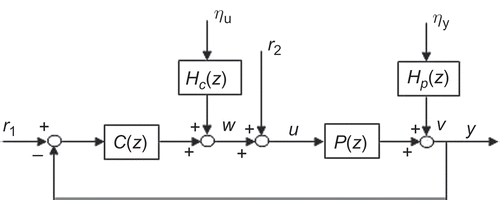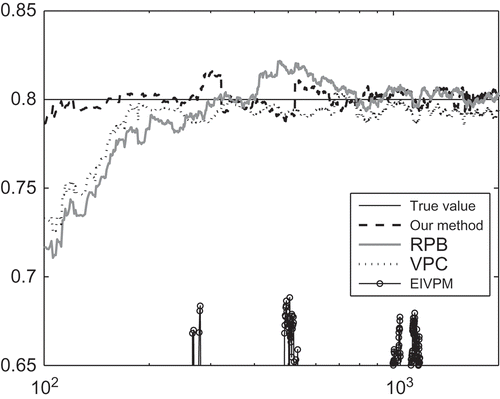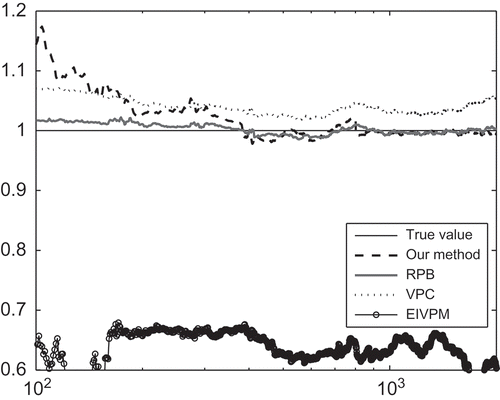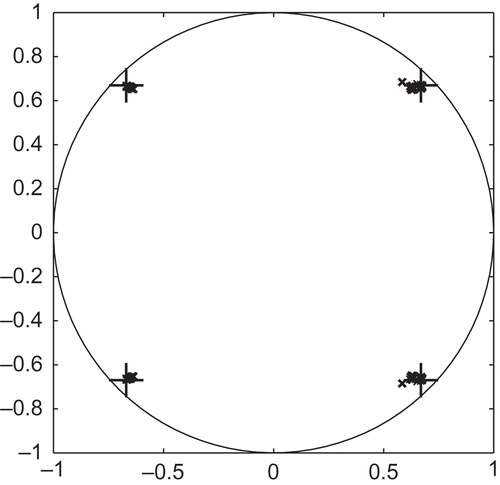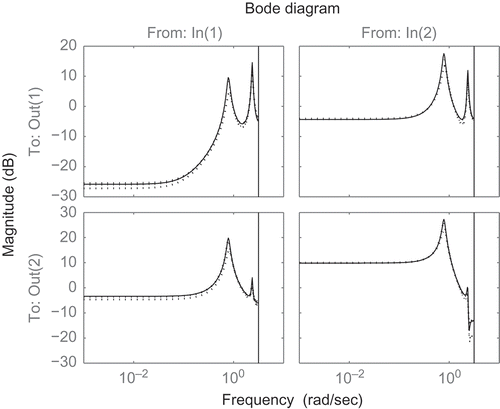Abstract
In this paper, a subspace model identification method under closed-loop experimental condition is presented which can be implemented to recursively identify and update the system model. The projected matrices play an important role in this identification scheme which can be obtained by the projection of the input and output data onto the space of exogenous inputs and recursively updated through sliding window technique. The propagator type method in array signal processing is then applied to calculate the subspace spanned by the column vectors of the extended observability matrix without singular value decomposition. The speed of convergence of the proposed method is mainly dependent on the number of block Hankel matrix rows and the initialization accuracy of the projected data matrices. The proposed method is feasible for the closed-loop system contaminated with coloured noises. Two numerical examples show the effectiveness of the proposed algorithm.
1. Introduction
Subspace Model Identification (SMI) has received much interest over the past two decades not only due to its convergency and numerical simplicity, but also for the state-space form that is convenient for estimation, filtering, prediction and control [Citation1,Citation2]. Most of these methods can achieve consistent estimates with open-loop or closed-loop data that construct input and output block Hankel matrices in order to retrieve certain subspaces related to the system matrices [Citation3–7]. However, these algorithms, which are only appropriate for offline identification, are difficult to implement online due to huge computational load of singular value decomposition (SVD) of related matrices.
As far as we know, in many cases, it is necessary to have a model of the system available online while the system is in operation [Citation8], such as the design of an adaptive model predictive controller. A possibility is provided by identifying a system under closed-loop condition using a recursive updating of the model. It meets the requirement that one of the dimensions of the block Hankel matrices involved needs to go to infinity in offline identification since updating technique is used. The main problem with the implementation of recursive SMI algorithms under closed-loop condition is to find alternative ways for SVD or avoid the application of the SVD. Several recursive algorithms for closed-loop subspace identification have been developed. In order to obtain unbiased parameter estimates, the vector auto regressive with exogenous input models from the work of [Citation9] has been introduced and the Projection Approximation Subspace Tracking (PAST) algorithm method is used to update the signal subspace in [Citation10]. The problem of recursive closed-loop subspace identification in [11] is presented by two linear optimization problems and subspace tracking techniques are developed to recursive SMI based on the relationship between sensor array processing (SAP) and SMI problems. In this paper, we present a new recursive subspace identification method under closed-loop conditions based on the orthogonal decomposition, which has been inspired and motivated by the offline version of the ORT-based method [Citation6]. The contributions of this paper are twofold. First, the approach overcomes the main difficulty in the identification of closed-loop system due to correlation between external inputs and noises resulting in biased estimates of plant model parameters. It provides asymptotically unbiased estimates of system matrices as the number of data samples goes to infinity. Second, this recursive approach overcomes practical difficulties of most closed-loop methods characterized batchwise identification with huge number of input and output sequences, such as acquiring, storing and analysing large data sets. We present a new updating scheme for the projected data matrix which applies sliding window technique to update data sequences to infinity and develops recursive construction for the LQ decomposition. Based on the propagator type method in the array signal processing, we obtain the subspace spanned by the column vectors of the extended observability matrix without SVD. In the simulation, the proposed method can achieve unbiased estimates in the presence of coloured noises in closed-loop system.
The remainder of this paper is organized as follows. In Section 2, we state problem formulation and introduce state-space model and notation. In Section 3, the projected data matrix is constructed online by the updating technique. In Section 4, a recursive identification algorithm is emphasized. In Section 5, two numerical examples are given and the results show the effectiveness of the proposed algorithm. Finally, in Section 6, we present the conclusion and prospect of the future research.
2. Problem formulation
Consider a closed-loop system depicted in . The plant is assumed to be modelled by , represented as a finite dimensional state-space model in the following. Let us assume that the signals
and
are observed. The disturbance signals
and
are white noise with mean zero. The matrices
and
are related noise filters, respectively. Furthermore, it is assumed that
| A1: | = | The feedback system is wellposed in the sense that |
| A2: | = | The controller |
| A3: | = | The exogenous inputs |
| A4: | = | The exogenous inputs and noises |
| A5: | = | There is no feedback from |
Based on the configuration of , we state the following closed-loop identification problem. Given the exogenous inputs and input output u, y, we derive a subspace identification method to estimate state-space models of the plant
recursively that is independent of the noise properties.
2.1. State-space model
Define and
. The whole infinite history of stationary processes is given. The Hilbert spaces are generated by second-order random variables of the exogenous inputs and joint input–output signals which are denoted by
and
. Then the ambient Hilbert space is given by
, where ‘
’ denotes the closed vector sum. We obtain the orthogonal projection of w onto
The further details of orthogonal decomposition of joint input–output process can be referred in [Citation6].
The plant of the closed-loop system shown in can be expressed with transfer function as
The orthogonal projection of Equation (5) onto is obtained based on the above the decomposition results,
Due to the external input signal, r is uncorrelated with the noise , all elements of
are close to 0 as
. Then we rewrite Equation (6) as
Define the finite history of second-order random variables of exogenous inputs which is a subspace of
at the time period
. Then, we take the orthogonal projection of Equation (6)
onto the space
and obtain,
2.2. Notation
Given the current data sequences , we construct reference input block Hankel matrix as:
The lower block triangular Toeplitz matrix is defined as:
3. Recursive update of the projected data matrix
In this and the next sections, we consider the projected data to recursively identify system matrices
of the plant
. The first step of the recursive algorithm is to construct and update the projected data matrix.
3.1. Construction of the projected data matrix
Based on the orthogonal projection in previous section, we define the projected data matrices and
and the stacked matrix
.
Lemma 3.1: Given block Hankel matrices ,
and
with data sequence
, the projected data matrix
can be obtained via the LQ decomposition as follows,
Proof: In the general case, the matrices A and B can be expressed as linear combinations of orthogonal matrix in terms of LQ decomposition as:
Thus, the orthogonal projection of the row space of A on the row space of B is denoted by
Applying the above result, we compute the orthogonal projection of the row space of onto
and mark the dimension of each matrix below and then have
In a similar way, we also obtain
It should be noted that rank()
must hold in order to apply the LQ decomposition in the next step. To ensure this condition, we have assumed that
has PE condition of order
. Then, the component
has PE condition of order
[Citation12].
3.2. Update the projected data matrix by sliding window
At the current time instant t, the data sequence is given. We define
At the th time instant, new observed data
is obtained to construct data vectors as following:
In a similar way, we obtain new data vectors and
. Thus,
Then, the new column is added and the old column
is eliminated and a new data matrix is obtained as
. The data matrix
is expressed into the LQ decomposition form:
Define and
,
is the ith row of the matrix
,
Clearly, the elements of the row are known but those of
are mostly unknown. Based on the definition of the LQ decomposition, the intermediate matrix
satisfies,
Due to the orthogonality of matrices and
, it is easy to obtain
Unfold Equation (27), the corresponding elements of both sides are equal and each element of the updated matrix can be computed via the Algorithm I in . In a similar way, we can obtain the matrix
.
Table 1. Algorithm I: update of the projected data matrix.
Note that we can obtain better estimates of initial projected data matrices and
from batchwise identification in order to avoid suffering from the convergence problem.
4. Recursive subspace identification of closed-loop system
After recursively updating the projected data matrix at th time instant, we can obtain
Then adjust the projected data matrix and compute the LQ decomposition as follows:
4.1. Recursive estimation of a basis of Γid
Consider the noise-free case, since the extended observability matrix with
, the matrix
has, at least,
linearly independent rows to guarantee the full rank, the following partition of the observation vector
can be introduced:
Moreover, an estimate of the extended observability matrix is available by estimating and that is
. In order to develop a recursive minimization algorithm, we introduce the forgetting factor
and obtain the cost function with a finite exponentially weighted sum as:
The minimization of such a criterion is recursively feasible by applying a classic recursive least squares approach. The estimation algorithm is summarized as Algorithm II in .
Table 2. Algorithm II: estimate of the extended observability matrix.
4.2. Computing the system matrices
By using the shift-invariance property of the extended observability matrix , the estimates
and
are directly obtained in the non-recursive case:
Once the matrices and
are fixed, the estimates of
and
can be computed. Pre-multiplying Equation (30) by
and post-multiplying by
yield,
Given the estimate of the extended observability matrix , the term
is linear with respect to parameters, so that we can easily obtain
and
by the least squares method.
5. Numerical examples
5.1. Example 1
In order to illustrate the performance of the proposed method in this paper, we consider the closed-loop system depicted in . There are three cases of the controller and the plant
displayed in . The noise models are given by
Table 3. Transfer functions used for simulation.
The reference inputs and
are zero mean Gaussian white signals with variances
. The noise input
is uncorrelated with the reference signals r and also is zero mean Gaussian white signal with variance
. For the data Hankel matrices, the user-defined index is chosen
. We use former 20 data samples to calculate the estimates of initial matrices. The order of the plant is assumed to be known as
.
We compare the representative recursive subspace algorithms VPC [10], RPB [11] and EIVPM [Citation14] with our method. Trajectories of estimated poles of the plant in three cases averaged over 30 independent Monte Carlo Simulation (MCS) and are displayed in Figures . As expected from and , the open-loop method EIVPM gives a biased result both in case 1 and case 2 because of the correlation of future inputs and past noises under the closed-loop condition. For case 1 and case 2, and demonstrate that VPC, RPB and our method have a remarkable ability to track the poles. As the number of samples increases, the results of estimated poles can be consistent with true value. It is also observed from and that the variance around the mean trajectories is much larger for the VPC than for our method and RPB.
Figure 4. Trajectories of estimated pole of the plant in case 3 and in case 3 with no noise by RPB and our method.

For case 3, there seem to be some difficulties in obtaining unbiased estimates of the plant by RPB and our method, as shown in the upper subplot of . We note that the plant
is an unstable system of which the pole is outside the unit circle. This observation does not mean that our method cannot always be applied to unstable systems. If the noise variance
is reduced to zero, the identification result of the unstable plant
can follow the estimated pole trajectory much better in the bottom subplot of . Moreover, our method presents faster convergence than the RPB method.
5.2. Example 2
We consider the following fourth-order multi-variable system described by
The innovation is an independent white noise sequence. The signal to noise ratio (SNR) is tuned to 20 dB.
To create a closed-loop system, the feedback gain matrix is chosen as that stabilizes the above system under closed loop over the whole trajectory. The reference signals
and
are zero mean Gaussian white noise signals with variance
. We assume that the dimension of the plant is
.
We performed 100 MCS experiments with different initial values which are properly chosen as zero or unit matrices. In , poles of the true system are marked by ‘+’. The poles of the identified system are shown by ‘x’ or shaded region which are estimated by the proposed method in the paper. It can be seen that our method successfully captures poles of the true system. Moreover, the red lines show the bode plots of the true system in . Bode plots of the estimated system in 100 MCS experiments by our method are displayed in dotted lines. It is observed from the that the true bode plots are covered by the estimated curves. We conclude that our method gives unbiased estimates of the identified system, though the fluctuation of the estimates of the output 1 from input 1 in lower frequency is somewhat large.
6. Conclusion and future work
Under the assumption that the order of a plant system to be identified is a priori known, we derive a recursive closed-loop SMI algorithm. The proposed algorithm updates the projected data matrix through linear equations and estimates the extended observability matrix based on the propagator method. The effectiveness of the algorithm has been demonstrated by two numerical simulation examples.
However, it should be noted that since the projection is onto the finite data space , the projected data
are not purely deterministic and do contain some residuals, or noises. It is clear as the window size
that is
The future work is to explore and improve the issues in terms of accuracy and speed of convergence of the algorithm.
References
- S.J. Qin, An overview of subspace identification, Comput. Chem. Eng. 30 (10–12) (2006), pp. 1502–1513.
- P. Van Overschee and B. De Moor, Subspace Identification for Linear Systems: Theory, Implementation, Applications. Dordrecht, Kluwer Academic Publishers, 1996.
- M. Gilson and G. Mercère. Subspace-based optimal IV method for closed-loop system identification, in Proceedings of the 14th IFAC Symposium on System Identification, IFAC, Newcastle, 29–31 March 2006, pp. 1068–1073.
- P. Van Overschee. Closed loop subspace system identification, in Proceedings of the 36th IEEE Conference on Decision and Control, IEEE, San Diego, CA, 10–12 December 1997, pp. 1848–1853.
- A. Chiuso and G. Picci, Consistency analysis of some closed-loop subspace identification methods, Automatica 41 (3) (2005), pp. 377–391.
- T. Katayama, H. Kawauchi, and G. Picci, Subspace identification of closed-loop system by the orthogonal decomposition method, Automatica 41 (5) (2005), pp. 863–872.
- G. Mercère, L. Bako, and S. Lecoeuche, Propagator-based methods for recursive subspace model identification, Signal Process. 88 (3) (2008), pp. 468–491.
- L. Ljung, System Identification: Theory for the User, Prentice-Hall, Upper Saddle River, NJ, 2002.
- T. Gustafsson, Instrumental variable subspace tracking using projection approximation. IEEE Trans. Signal Process. 46 (3) (1998), pp. 669–681.
- P. Wu, C. Yang, and Z. Song, Recursive subspace model identification based on vector autoregressive modelling, in Proceedings of the 17th IFAC Symposium on Automatic Control, IFAC, Seoul, 6–11 July 2008, pp. 8872–8877.
- I. Houtzager, J. Van Wingerden, and M. Verhaegen, Fast-array recursive closed-loop subspace model identification, in Proceedings of the 15th IFAC Symposium on System Identification, IFAC, Saint-Malo, 6–8 July 2009, pp. 96–101.
- I. Markovsky, J.C. Willems, P. Rapisarda, and B. De Moor, Algorithm for deterministic balanced subspace identification, Automatica 41 (5) (2005), pp. 755–766.
- T. Katayama and H. Tanaka, An approach to closed-loop subspace identification by orthogonal de-composition, Automatica 43 (2007), pp. 1623–1630.
- G. Mercè re, S. Lecoeuche, and C. Vasseur, A new recursive method for subspace identification of noisy systems: EIVPM, in Proceedings of the 13th IFAC Symposium on System Identification, Elsevier, Rotterdam, 27–29 August 2003, pp. 1637–1642.
Appendix A. The property of orthogonal projection
Let X, and
be three spaces with
, so that dim
. Find
and denote
In addition, a similar property holds for conditional expectation, if we consider are (sub)
-algebras,
can be replaced by E.
